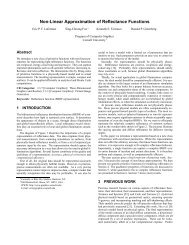pigmented colorants: dependence on media and time - Cornell ...
pigmented colorants: dependence on media and time - Cornell ...
pigmented colorants: dependence on media and time - Cornell ...
Create successful ePaper yourself
Turn your PDF publications into a flip-book with our unique Google optimized e-Paper software.
materials–an artist will know from experience how different pigment-<strong>media</strong> com-<br />
binati<strong>on</strong>s behave. While this problem is quite difficult, most paint <strong>media</strong> can be<br />
reworked until the desired result is achieved. The inherent problem with fresco is<br />
that a dried brushmark is permanent <strong>and</strong> cannot be reworked. Thus, <strong>on</strong>e needs to<br />
underst<strong>and</strong> the <strong>time</strong> dependencies to correctly match colors between sessi<strong>on</strong>s. The<br />
color matching problem can readily be seen in the hue discrepancies in Masaccio’s<br />
giornate in his Expulsi<strong>on</strong> from the Garden of Eden (Figure 1.2).<br />
The same problem occurs with the c<strong>on</strong>servator’s practice of in-painting <strong>on</strong><br />
losses of paintings. Occasi<strong>on</strong>ally, a painting will experience damage to the surface<br />
whereas a porti<strong>on</strong> of the work has chipped off. One comm<strong>on</strong> technique of is to<br />
first disguise the loss with filling to regain the surface topology. The new surface<br />
is then retouched to match the current color, which places a large resp<strong>on</strong>sibility<br />
<strong>on</strong> correctly identifying the original pigments. Further, the fresh paint must be<br />
mixed such that the fresh mixture will age at a similar rate to that of the original<br />
surrounding colors. This is difficult as the original artwork will be at a much later<br />
stage in fading <strong>and</strong> will change at a much different rate to that of fresh paint.<br />
While a c<strong>on</strong>servator may have carefully matched an in-painting secti<strong>on</strong>, the false<br />
area may display itself later in its own fading cycle. The difficulty of retouching<br />
artworks is further documented in [Sta85].<br />
There is an importance c<strong>on</strong>sequence of the artist c<strong>on</strong>trolling the initial c<strong>on</strong>di-<br />
ti<strong>on</strong>s of a paint. The artist knows the desired color for his or her artistic visi<strong>on</strong>.<br />
Then, <strong>on</strong>e can use knowledge of the evoluti<strong>on</strong> of a paint in order to modify the<br />
fresh paint such that the aged paint will be the desired result. This changes the<br />
c<strong>on</strong>cepti<strong>on</strong> of the term “artwork”, as the original is not necessarily the creative<br />
185<br />
visi<strong>on</strong>. Rather, the evolving work moves incrementally closer to the artist’s intent



